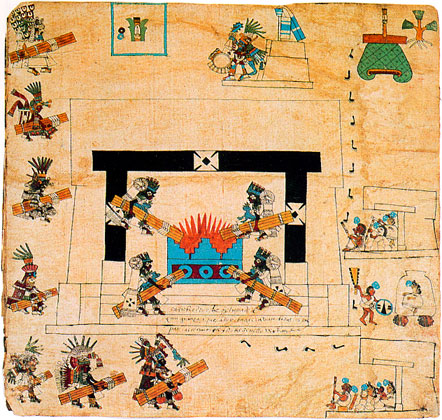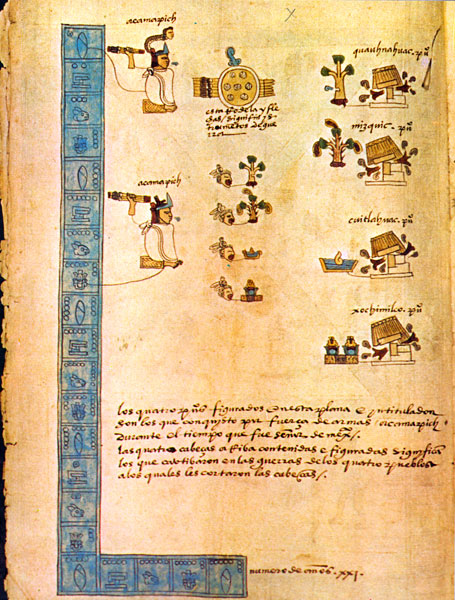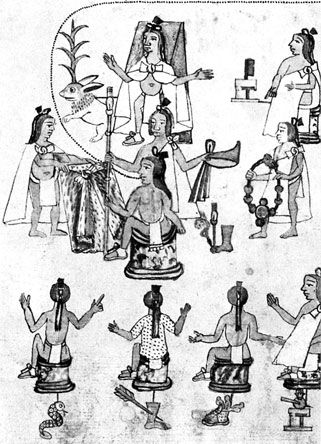Yvonne confuses the origin of Quauhnahuac ("near the wood") with that of Tenochtitlán, the Aztec capital and later site of Mexico City. In 1325 the wandering Aztecs near the lake of Texcoco saw an eagle on a nopáli cactus with a serpent in its talons and wings open to the rising sun; this they took as an omen that here was to be their future city, the emblem of eagle, cactus and serpent to this day depicted on the Mexican flag and coat of arms. The illustration depicts the foundation of Tenochtitlán (1325) and its history until 1375, when Tenochtli died, after a reign of 51 years. Each blue square represents one year, reading clockwise around the margin. Each month had 20 days, named after things or animals (there were 18 months in a year, with 5 "unlucky days" left over). Each year was named after its first day, and the year, having 365 days, could only begin with four day-names: House, Rabbit, Reed and flint Knife. The Aztec century consisted of 52 years, which were counted by combining these four symbols with blue dots, from one to thirteen (4 x 13 = 52). Every 52 years the Aztecs thought that the world might end; in order for life to continue, the New Fire had to be kindled. Hence the fire-drilling glyph over the year Two Reed, in the lower right-hand corner (1351). The eagle, cactus fruit and rock in the middle symbolize Tenochtitlan and its origin. The Mexican shield, with seven eagle-down feathers, and the bundle of spears denote the authority of the Aztec lords. The large blue cross, the blue square, and various plants denote Lake Texcoco. Tenochtli, the Aztec chief, sits on a palm leaf mat. symbolizing power. His name means "stone prickly-pear" (tetl, stone, nochtli, prickly pear), as in the glyph behind him. The blue speech scroll denotes authority. Other seated figures are high-ranking warrors. From Kurt Ross, Codex Mendoza, frontispiece.

The Aztecs associated the Pleiades with the fear of the world coming to an end every fifty-two years. The passage from one fifty-two-year cycle to another was marked by an important ritual. At sunset the priests climbed to the temple at the top of the hill known as Cerro de la Estrella, or Hill of the Star, and waited for the appearance of the Pleiades. A new fire was lit in the open chest of a victim, then runners set their torches ablaze and relit the altars. Diagram from Gruzinski, The Aztecs, 33.

The glyph representing Quauhnahuac in the Aztec codices is that of a talking tree, as at the upper right, the accompanying image suggesting its destruction. Kurt Ross, Codex Mendoza, 21.

For the Aztecs, the foolish rabbit was an emblem of drunkeness, a crime punishable by death; and a rabbit in the house was a sign of bad luck. The intimations for the Consul in the Farolito are not promising. Here, an Aztec chief is being adorned with his trappings of state while attendants look on. The rabbit at the top, with a maguey plant apparently sprouting from his head, represents the alcoholic beverage, pulque. From Karl E. Meyer, Teotihuacán, 107.
